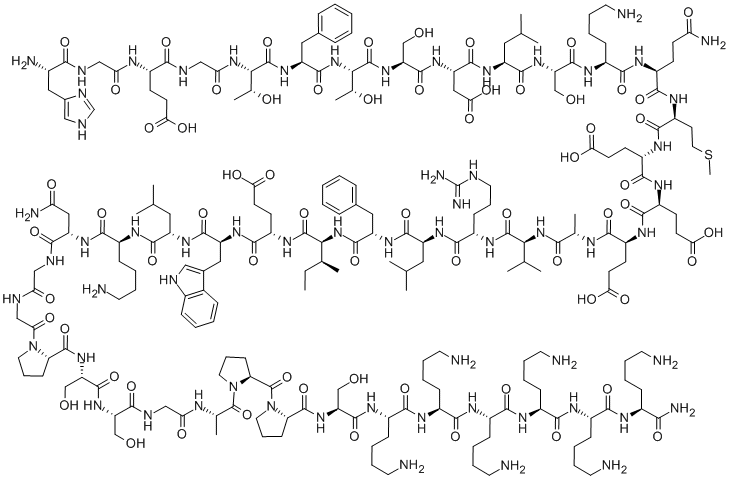All AbMole products are for research use only, cannot be used for human consumption.

Lixisenatide (ZP10A peptide) is a glucagon-like peptide-1 (GLP-1) receptor agonist, which is a hormone that helps normalize blood sugar levels. Lixisenatide protects Ins-1 cells (a rat-derived β-cell line) from both lipid- and cytokine-induced apoptosis. Lixisenatide also prevents lipotoxicity-induced insulin depletion in human islets and preserves insulin production, storage and pancreatic β-cell function in vitro.
In ZDF rats, a continuous subcutaneous infusion of lixisenatide 50 μg/kg/day for 12 weeks significantly decreases basal blood glucose and improves oral glucose tolerance compared with control animals. It has no hypoglycemic effect and does not change HbA1c in normoglycemic rats. Lixisenatide can maintain beta cell mass and function through stimulation of islet cell proliferation and neogenesis, and inhibition of islet cell apoptosis.
| Cell Experiment | |
|---|---|
| Cell lines | both cytokine- and FFA-treated cells |
| Preparation method | In both cytokine- and FFA-treated cells, Lixisenatide (10 nM) significantly decreased caspase-3 activity, and decreased the amount of apoptotic cells by 50–60% (similar to the effect seen with 10 nM GLP-1 or exendin-4) . |
| Concentrations | 10 nM |
| Incubation time | - |
| Animal Experiment | |
|---|---|
| Animal models | |
| Formulation | |
| Dosages | |
| Administration | |
| Molecular Weight | 4858.53 |
| Formula | C215H347N61O65S |
| CAS Number | 320367-13-3 |
| Solubility (25°C) | Water 90 mg/mL |
| Storage | -20°C, dry, sealed |
| Related GLP Receptor Products |
|---|
| 3-Deoxyglucosone
3-Deoxyglucosone (3-Deoxy-D-glucosone) is a reactive intermediate of the Maillard reaction and the polyol pathway. 3-Deoxyglucosone rapidly reacts with protein amino groups to form advanced glycation end products (AGEs). 3-Deoxyglucosone inactivates glutathione peroxidase and synergizes with low glucose to enhance GLP-1 secretion. 3-Deoxyglucosone is used as a biomarker for diabetes mellitus. |
| V-0219 hydrochloride
V-0219 hydrochloride is an orally active, positive allosteric modulator (PAM) of the glucagon-like peptide-1 receptor (GLP-1R). |
| GLP-1 receptor agonist 14
GLP-1 receptor agonist 14 is a potent agonist of glucagon-like peptide-1 (GLP-1). |
| NM-003
NM-003 is a GLP-2R agonist that can be used in studies related to inflammatory bowel disease. |
| NB-1002
NB-1002 is a GLP-2R agonist that can be used in studies related to short bowel syndrome. |
All AbMole products are for research use only, cannot be used for human consumption or veterinary use. We do not provide products or services to individuals. Please comply with the intended use and do not use AbMole products for any other purpose.


Products are for research use only. Not for human use. We do not sell to patients.
© Copyright 2010-2024 AbMole BioScience. All Rights Reserved.
